White rot of sunflower: causes, harm and distribution
The manifestation and development of white rot depends on air humidity and soil and air temperatures. Massive damage to sunflower is observed in areas with high humidity and in years with frequent precipitation. The intensity of white rot of the root system and the basal part of the stem depends on the amount of precipitation that fell in the first half of the sunflower growing season. White head rot develops massively from precipitation during the flowering and ripening period.
The harmfulness of white rot is expressed in a decrease in yield, sowing and marketability of seeds and depends on the time of infection. Sunflower affected at a young age dies. On a plant infected at a later stage, although seeds are formed, they are lightweight, often have a destroyed embryo and contain significantly less oil. There are 5-20 times more empty and shriveled seeds from affected plants than from healthy ones. In addition, 35-90 seeds with sclerotia are found in the affected basket. The oil from them has a bitter taste.
Most often, the infection is transmitted through sclerotia. Sclerotia are tightly woven fungal hyphae covered with a dense protective layer of pigmented cells. The larger the sclerotium, the longer its ability to infect plants (8-12 years or more). Small sclerotia shaken out of the affected basket and large sclerotia crushed by harvester tools during harvesting (either by a reaper or a threshing drum) fall into the soil in the fall during harvesting.
The seeds sown in the spring germinate underground, where the sclerotia are dormant. In moist soil, the seedling grows and comes into contact with the sclerotia. This is how sunflower is affected by the presence of a soilborne white mold infection. The seedling touches the sclerotium and the sclerotium grows mycelium into the plant tissue while still underground. The closer the sclerotium is to the root of the seedling, the faster the damage occurs, which is clearly shown in the diagram of contact between the sclerotia of white mold due to soil and aerogenic infection with the sunflower plant.
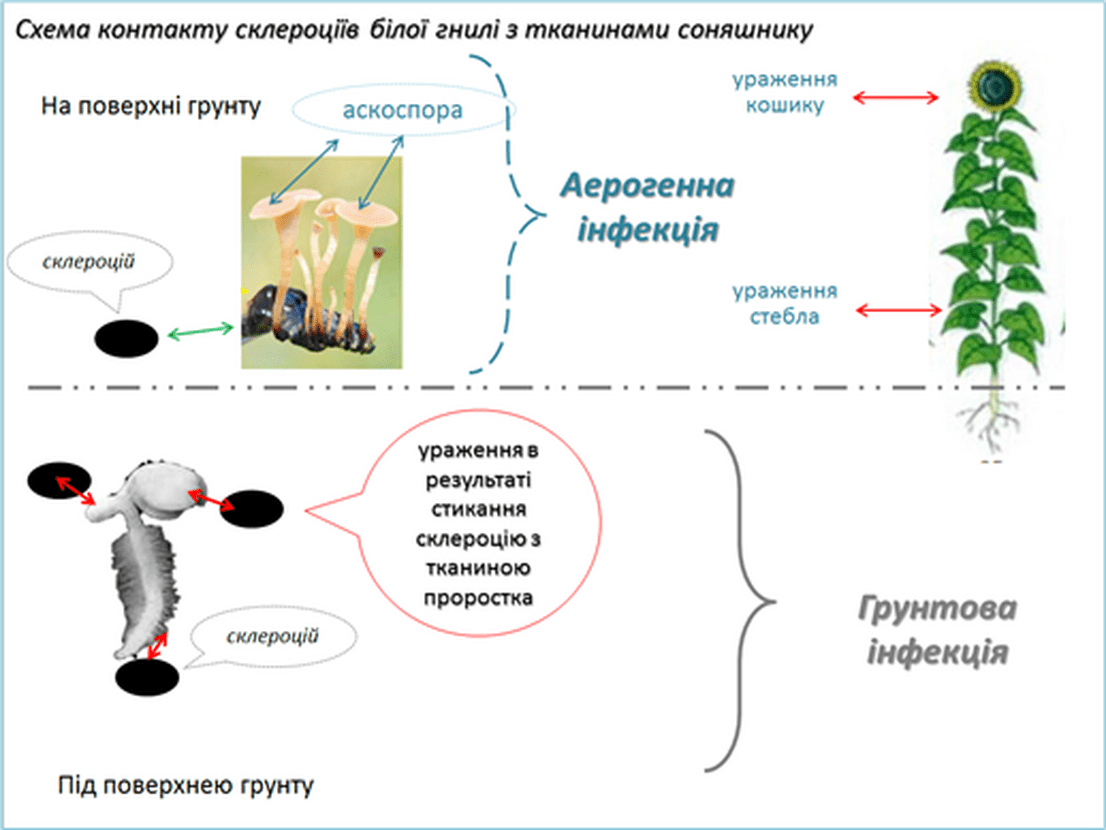
After sowing, every landowner is anxiously awaiting the seedlings. But what can they see instead of slender rows of unfolded cotyledons?
Firstly, in case of early damage (contact of sclerotia with sprouted seeds underground), sunflower seedlings may fail when the affected plants do not even appear above the soil surface. Secondly, from the emergence of seedlings to the third pair of leaves, plants affected by white rot may sometimes appear in the crop, which is caused by the growth of roots to sclerotia located in deeper soil layers.
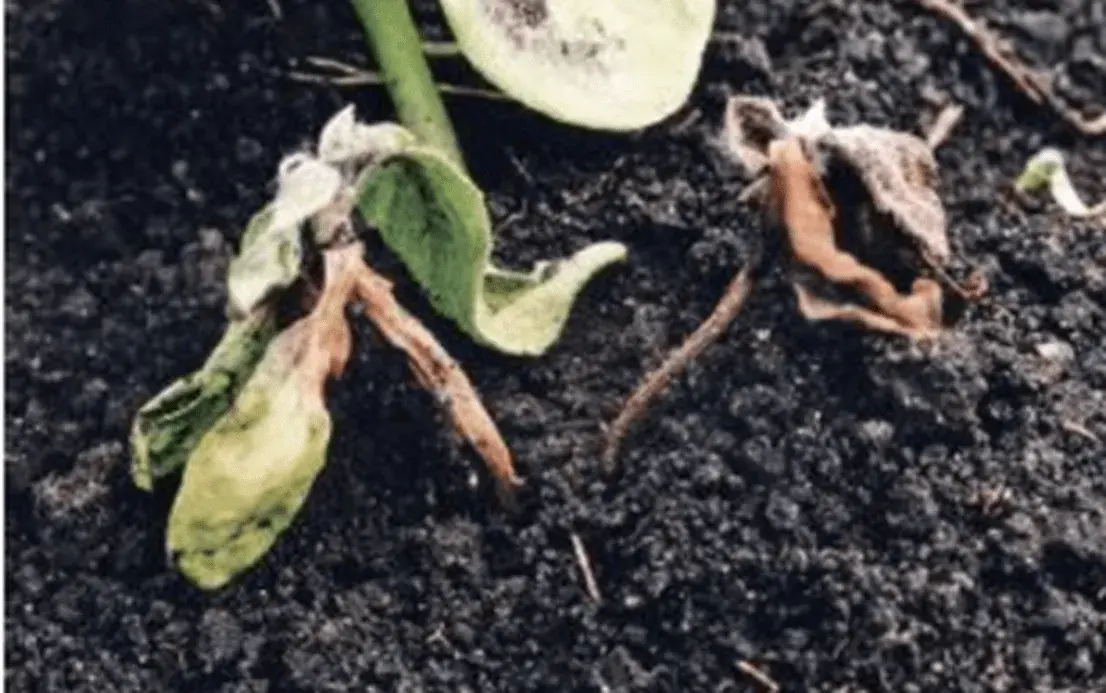
A typical symptom of white rot is that, under high moisture conditions, the roots soften, become slimy and covered with a white coating, the mycelium of the pathogen.
We have carefully considered the results of the harmful effects of white mold on plants in the initial stages of crop growth, but as plants grow and come into contact with sclerotia, which is a soil infection of white mold, later damage is possible.
In the second half of the sunflower growing season, during prolonged rainfall or periodic stormy weather, i.e. in wet weather during leaf formation, bud formation and almost before flowering, white mold infection occurs with the help of an aerogenous infection - ascospores (see Fig. 1), the primary inoculum, which is a powerful weapon among the diversity of species of the Kingdom of Fungi.
Large, unplowed sclerotia on the soil surface germinate with apothecia, in the cavity of which ascospores are formed. They are carried by air masses and affect the sunflower tissues - stems and baskets. In wet conditions, the disease develops rapidly.
Stem damage
In the middle part of the stem, in the place where the petiole and stem are attached, rain drops flow down. It is from there that a light brown (flesh-colored) spot appears, which radially spreads along the stem, covering it (Fig. 5).
Due to the super-fast formation of sclerotinia mycelium and its spread inside the plant, the conductive bundles of the stem are clogged and the plant sap is intoxicated with the products of the fungus' vital activity - oxalic acid.
The periphery of the leaf blade of each leaf on the plant becomes brownish-gray in color. The leaves, like the plant itself, droop (Fig. 3). A diagnostic sign of sclerotinia wilt is the presence of a flesh-colored spot that covers the stem.
The upper part of the stem droops, the leaves wither and eventually the plant dies. If precipitation stops later, the stems in the affected areas still break. Due to the spread of the fungal mycelium inside the stem, the tissues are destroyed, the conductive bundles are exposed, the stem core dries out, and numerous black sclerotia of dense consistency and various shapes are formed in the cavity. A striking diagnostic sign of sunflower damage by the pathogen white rot is zonation. In Figure 5a, it is more evident, but it is also present on the broken stem.
After the manifestation in the form of wilt, which is usually diagnosed even during the flowering period of sunflower, an even later lesion is possible. So late that the plant manages to form a crop.
Damage to the baskets
After ascospore damage, a light brown spot, as it were, of flesh color, forms on the back of the baskets (Fig. 6). In contrast to the damage to the basket tissues by the gray rot pathogen, the tissues affected by S. sclerotiorum are even wetter in appearance and can be easily pressed with a finger. In the case of precipitation of significant intensity, drops knock particles from the affected spot from the affected plant and they fall on those growing around nearby. In this way, white mold spreads rapidly and foci are formed, which over the course of prolonged rains re-infect more and more plants in the crop.
If the air humidity is high, a white coating appears in the areas of the spots, which spreads over the surface of the head or penetrates the head tissue. If the mycelium penetrates the parenchyma to the seed side of the head, black sclerotia in the form of a lattice form between the seeds. The kernel of the affected seed darkens inside and tastes bitter. Subsequently, the tissue of the affected baskets is completely destroyed, disintegrates, and only the vascular elements remain intact (Fig. 7). The sclerotia and affected seeds crumble and are subsequently plowed into the soil.
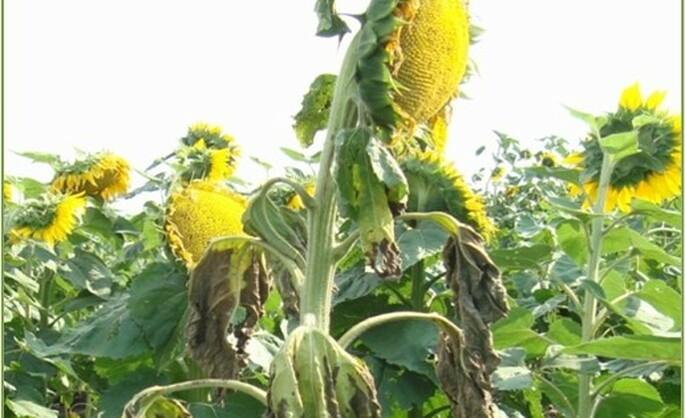
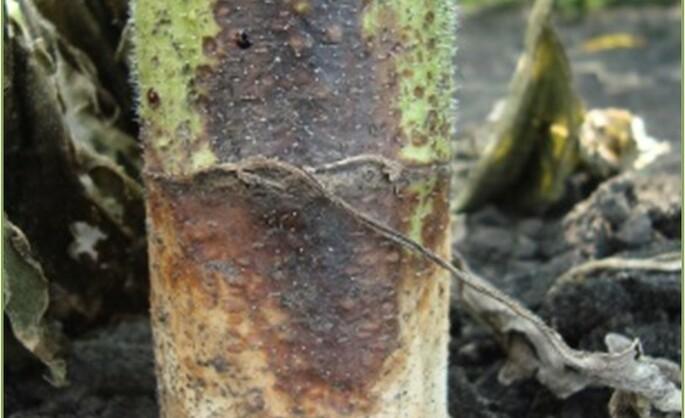
In addition, seeds from affected plants may carry a latent form of white mold, a seed infection in the form of mycelium in the embryo. Even with treatment, such seeds will not germinate in the field the next year, due to maceration of cotyledon tissue inside the husk.
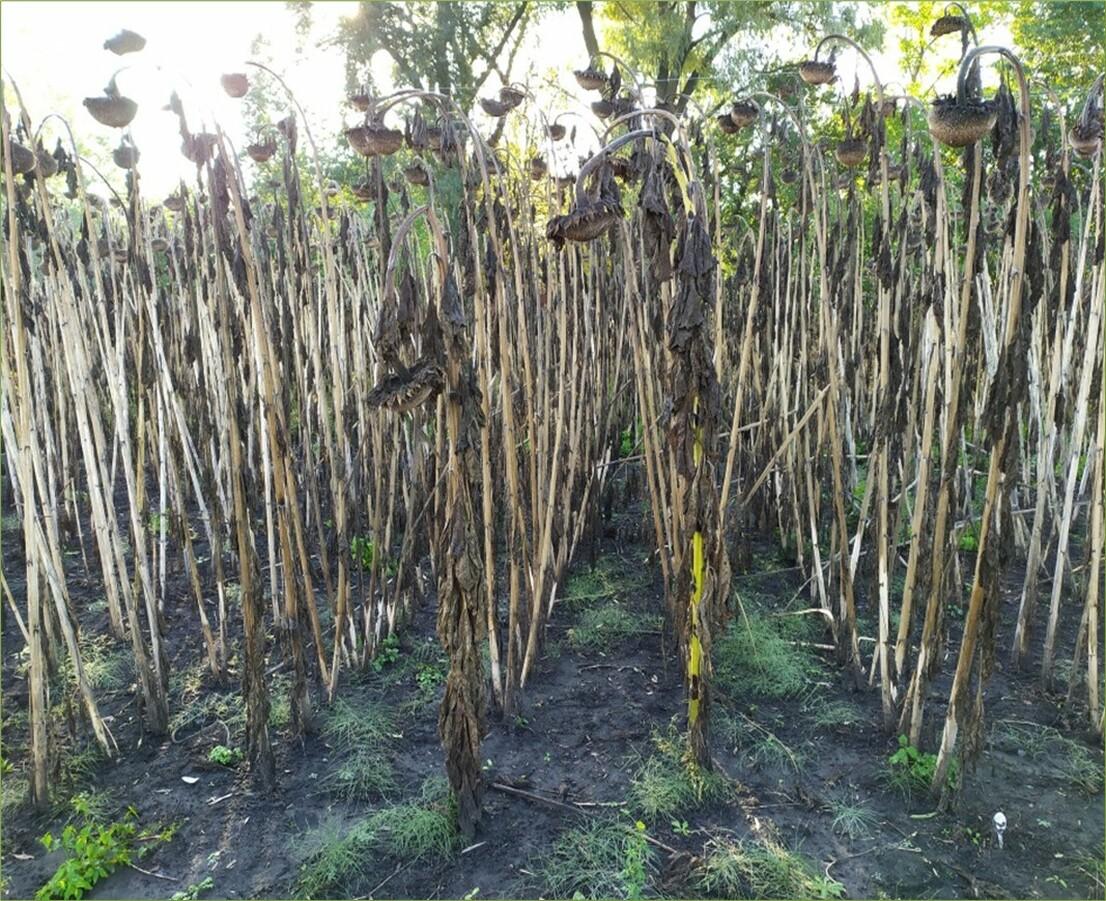
Thus, the sources of infection are:
- affected plant residues left after harvesting;
- affected plant tissues penetrated by the pathogen's mycelium during rains during the sunflower growing season;
- sclerotia in the form of impurities that are sown into the soil together with seeds;
- infected seeds, which contain mycelium and sclerotia of the pathogen;
- sclerotia plowed or not plowed into the soil.
Most sclerotia of the fungus that enter the soil with plant residues remain viable for 7-10 years.
Factors contributing to the spread of infection and disease development:
- air temperature of +20...+26°C against the background of high humidity;
- prolonged thick fogs during plant maturation;
- rainy weather with high wind speed;
- placement of the crop after rapeseed, hemp, legumes, buckwheat, cucumbers, cabbage, carrots, etc;
- reduced crop rotation in the crop rotation;
- application of excessive doses of nitrogen fertilizers;
- crops with excessive plant density;
- sunflower crops with a high degree of weediness.
Phosphorus and potassium fertilizers have a positive effect on reducing the severity of sunflower sclerotinia. The introduction of trace elements (zinc, manganese, cobalt, molybdenum) enhances the effect of phosphorus-potassium fertilizers. Their effectiveness increases with increasing soil moisture.
The development of the root form of white rot is enhanced by thickening of crops.

 Choose a country
Choose a country